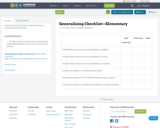
A checklist used by teachers to assess elementary students’ generalizing skills.
- Subject:
- English Language Arts
- History
- Life Science
- Mathematics
- Physical Science
- Social Science
- Material Type:
- Assessment
- Date Added:
- 07/03/2017

A checklist used by teachers to assess elementary students’ generalizing skills.

A rubric in student language used by elementary students to assess their generalizing skills.
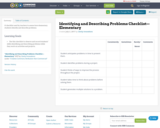
A checklist used by teachers to assess how elementary students identify and describe problems.
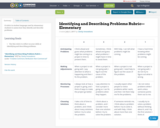
A rubric in student language used by elementary students to assess how they identify and describe problems.
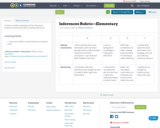
A rubric in student language used by elementary students to assess their skills at making inferences.
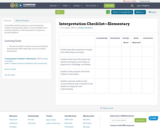
A checklist used by teachers to assess elementary students’ interpretation skills. It can be modified to be used by students as a self-assessment or by peers to provide feedback.

To promote Interaction and CommunicationLesson titleLesson for learners with not much English or education backgroundAbstractThis is a group-work lesson designed for students with low-intermediate communication skills and not much educational back ground. The purpose of this lesson is to assist students to communicate with others and the community on the whole. It will also work to improve specific issues and challenges the student might face.* Low-intermediate communication skills:- Persons showing low or intermediate communications skills that is one who does not possess or show much communications skills. (low level, having no functional ability, intermediate having limited functional ability)* Not much educational background:- With little or no educational background. (limited reading/writing or no reading/writing skills and mathematics knowledge and skills)Issues and challenges that learners may face:-Emotional and social and relationship skills, self-management and self/social awarenessLife skills, financial literacy and managementEmployability skills, teamwork and engagement or collaboration, effective communicationThinking skills, problem solving, critical and reasoning thinkingLearner Audience / Primary UsersThis lesson is intended for a classroom setting with learners in groups of four to six. The content included in the lesson is targeted at learners with limited English communication skills. The lesson is specifically targeted at persons with but not limited to adults with low level educational back ground and who might be experiencing some level of low self-esteem.Educational UseModuleQualification & experienceCollege & Career Readiness Standards AlignmentLevel: Adult EducationGrade Level: BSubjects: English Language Arts / Literacy & Computer literacyReadingAnalyze the impact of the author’s choices regarding how to develop and relate elements of a story or drama (e.g., where a story is set, how the action is ordered, how the characters are introduced and developed).Determine two or more themes or central ideas of a text and analyze their development over the course of the text, including how they interact and build on one another to produce a complex account; provide an objective summary of text.Know and use various text features; subheadings, glossaries, indexes, electronic menus, icons, to locate key facts or information in a text efficiently.Determine the meaning of words and phrases as they are used in the text, including figurative and connotative meanings; analyze the impact of specific word choices on meaning and tone, including words with multiple meanings or language that is engaging, or beautiful.Examine multiple interpretations of a story, drama, or poemEvaluate ways authors develop point of view and style to achieve specific impression and purpose. Speaking and ListeningEngage effectively in a range of collaborative discussions (one-on-one, in groups, and teacher-led) with diverse partners, building on others’ ideas and expressing their own clearly. Ask and answer questions about information from a speaker, offering some form of elaboration. Computer skillsGive the learner a working knowledge of the hardware that comprises a personal computer.Develop the learner's ability to use introductory Windows commands for file management.Introduce the learner to the Internet and the use of electronic research and web-based communication methods.Enable the student electronically to research the library.Introduce the student to the methods of searching the Internet and the problems associated with using the research materials. LanguageEnglishMaterial TypeInstructional MaterialLearning GoalsIn this lesson ABE learners will:Demonstrate good reading and literature skillsCompose open ended question for research or assignmentsDevelop clear and coherent writing skillsUse the computer Time Required for each Lesson40 – 60 minutesPrior KnowledgeBe able to read at an elementary level but not necessarilyRequired ResourcesStudent willingness to learnInternetLibraryExperience teacherComputer labpen/pencil and note book
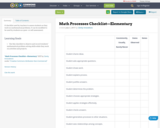
A checklist used by teachers to assess students as they work on mathematical problems. It can be modified to be used by students as a peer- or self-assessment.
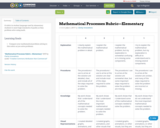
A rubric in student language used by elementary students to meet high standards of quality as they problem solve using math.

A rubric in student language used by elementary students to self-assess their problem solving and reasoning skills.
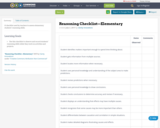
A checklist used by teachers to assess elementary students’ reasoning skills.
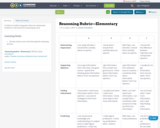
A rubric in student language written for elementary students to self-assess the reasoning process.
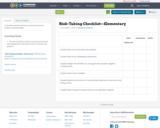
A checklist used by teachers to assess elementary students’ thinking skills.
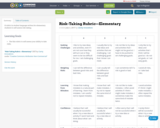
A rubric in student language written for elementary students to self-assess risk-taking.
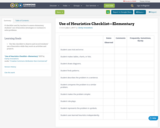
A checklist used by teachers to assess elementary students’ use of heuristics (strategies or routines) to solve problems.
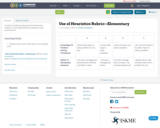
A rubric in student language used by elementary students to meet high standards of quality as they problem solve.